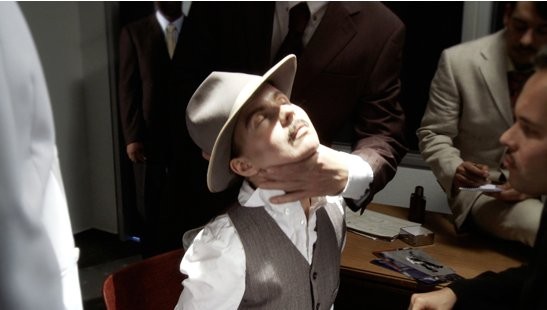Rebecca Ann Tess
02 Apr - 28 May 2011

© Rebecca Ann Tess
A Crime must be Committed, 2010
HD video projection, 16:9, colour
13 min, English
(Video still)
A Crime must be Committed, 2010
HD video projection, 16:9, colour
13 min, English
(Video still)
REBECCA ANN TESS
A Crime must be Committed
2 April - 28 May, 2011
We are proud to present – on the occasion of the opening of our new space in Berlin – the second solo exhibition of Rebecca Ann Tess on April 2, 2011 at 7pm.
The video installation A Crime must be Committed is the second instalment of a three-part series, addressing the historical shifts in presentation of characters in European and US film and television history.
In A Crime must be Committed Tess cites and alters typical scenes of the crime and detective film genre, such as gangster-films of the 1920s, (Underworld, 1927), film noir (The Maltese Falcon, 1941) neo-noir, (The Detective, 1968), crime thrillers, (Die Hard, 1988; Shaft, 1971 and 2000), and the contemporary criminal investigation series (CSI, from 2000). The artist follows the historical development of the detective figure and his relationship to the criminal, as well as the power relation between the characters that changes over time. The video refuses to follow a chronological order that normally structures historiography. The tension as well as the case of the criminal film remain unresolved. The loop leaves beginning and end undefined and depending at what moment the viewer starts and ends watching a different version of the traditional cops and robbers’ story appears.
Fear is not only an important dramaturgical component of a detective and crime film, it also often plays a role in Hollywood productions, in order to affirm the targeted white male in his identity. Different situations in which those fears are invoked and repelled are the topic of Tess’ new series of collages exhibited for the first time. The pictures are printed on acrylic glass, so that the background shines through and the frontal light casts shadows on the wall of the gallery. These pictorial objects seem to connect the origin of film and photography, namely celluloid and glass negative, and the contemporary way of presenting images on flat screens. Characters and constellations of figures appear in which fears of the society are inscribed. These are fears that lead to oppression and discrimination and that are here multiplied and intensified to the monstrous. They develop a life of their own in the frameless windows to the media dream world.
A Crime must be Committed
2 April - 28 May, 2011
We are proud to present – on the occasion of the opening of our new space in Berlin – the second solo exhibition of Rebecca Ann Tess on April 2, 2011 at 7pm.
The video installation A Crime must be Committed is the second instalment of a three-part series, addressing the historical shifts in presentation of characters in European and US film and television history.
In A Crime must be Committed Tess cites and alters typical scenes of the crime and detective film genre, such as gangster-films of the 1920s, (Underworld, 1927), film noir (The Maltese Falcon, 1941) neo-noir, (The Detective, 1968), crime thrillers, (Die Hard, 1988; Shaft, 1971 and 2000), and the contemporary criminal investigation series (CSI, from 2000). The artist follows the historical development of the detective figure and his relationship to the criminal, as well as the power relation between the characters that changes over time. The video refuses to follow a chronological order that normally structures historiography. The tension as well as the case of the criminal film remain unresolved. The loop leaves beginning and end undefined and depending at what moment the viewer starts and ends watching a different version of the traditional cops and robbers’ story appears.
Fear is not only an important dramaturgical component of a detective and crime film, it also often plays a role in Hollywood productions, in order to affirm the targeted white male in his identity. Different situations in which those fears are invoked and repelled are the topic of Tess’ new series of collages exhibited for the first time. The pictures are printed on acrylic glass, so that the background shines through and the frontal light casts shadows on the wall of the gallery. These pictorial objects seem to connect the origin of film and photography, namely celluloid and glass negative, and the contemporary way of presenting images on flat screens. Characters and constellations of figures appear in which fears of the society are inscribed. These are fears that lead to oppression and discrimination and that are here multiplied and intensified to the monstrous. They develop a life of their own in the frameless windows to the media dream world.
